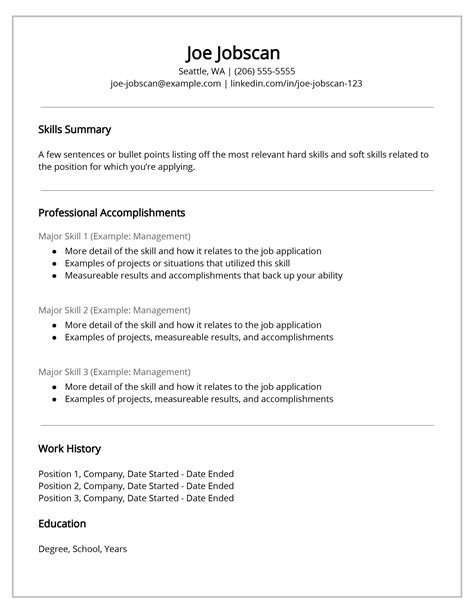Expert Tips: Functional Resume Example & Writing Advice

Are you struggling to create a winning resume? Do you feel like your skills and experience aren’t being properly highlighted? If so, it may be time to switch to a functional resume. Unlike a traditional chronological resume, a functional resume focuses on your skills and achievements rather than your work history. In this post, we’ll provide you with a functional resume example and expert writing advice to help you create a standout resume that will get you noticed by employers.
What is a Functional Resume?
A functional resume is a type of resume that highlights your skills and achievements rather than your work history. This type of resume is ideal for those who have gaps in their work history, are changing careers, or have a lot of relevant skills and experience that aren’t necessarily tied to a specific job or position.
The Benefits of a Functional Resume
- Highlight Your Skills: A functional resume allows you to showcase your skills and achievements in a way that a traditional resume doesn’t.
- Stand Out from the Crowd: A functional resume can help you stand out from other candidates who are using traditional resumes.
- Address Employment Gaps: If you have gaps in your employment history, a functional resume can help you address them without drawing too much attention to them.
- Emphasize Your Accomplishments: A functional resume puts the focus on your accomplishments and what you can bring to the table, rather than just your work history.
How to Write a Functional Resume
Now that you know what a functional resume is and the benefits of using one, let’s dive into how to write a functional resume step-by-step:
Step 1: Choose the Right Format
When it comes to choosing the right format for your functional resume, you have a few options:
- Skills-Based Resume: This type of resume focuses on your skills and accomplishments, with your work history listed at the bottom.
- Combination Resume: This type of resume combines both chronological and functional formats, highlighting your skills and achievements while also listing your work history.
Step 2: Tailor Your Resume to the Job
When creating a functional resume, it’s important to tailor it to the job you’re applying for. This means looking at the job description and highlighting the skills and experience that match what the employer is looking for. Use keywords from the job description in your resume to help your application get past any automated screening systems.
Step 3: Highlight Your Skills
Your skills section should be the main focus of your functional resume. List your skills in a clear and concise manner, and provide examples of how you’ve used those skills in previous positions. Use bullet points to make your skills stand out and ensure they are easy to read and understand.
Step 4: Include Relevant Work Experience
While a functional resume doesn’t focus on your work history, it’s still important to include relevant work experience. List your previous positions in reverse chronological order, and provide a brief description of your responsibilities and accomplishments in each role.
Step 5: Add Education and Certifications
Include your education and any certifications that are relevant to the job you’re applying for. List your highest degree first, and include the name of the institution, your degree, and your graduation date.
Step 6: Use Action Words
Use action words to describe your skills and accomplishments. Action words are powerful and can help your resume stand out. Examples of action words include “achieved,” “developed,” “created,” and “managed.”
Step 7: Keep it Concise
A functional resume should be no longer than two pages. Keep your resume concise and to the point, focusing on your skills and accomplishments rather than your work history. Use bullet points and short sentences to make your resume easy to read and scan.
FAQs
What is the difference between a functional resume and a chronological resume?
A functional resume focuses on your skills and achievements, while a chronological resume focuses on your work history.
When should I use a functional resume?
A functional resume is ideal for those who have gaps in their work history, are changing careers, or have a lot of relevant skills and experience that aren’t necessarily tied to a specific job or position.
What should I include in my skills section?
Your skills section should include a list of your skills, with examples of how you’ve used those skills in previous positions.
Can I use a functional resume for any job?
A functional resume can be used for any job, but it’s important to tailor it to the job you’re applying for.
How long should my functional resume be?
Your functional resume should be no longer than two pages.
Creating a functional resume can be a great way to showcase your skills and achievements, and it can help you stand out from other candidates. By following these expert tips and using our functional resume example, you’ll be well on your way to creating a standout resume that will get you noticed by employers.
